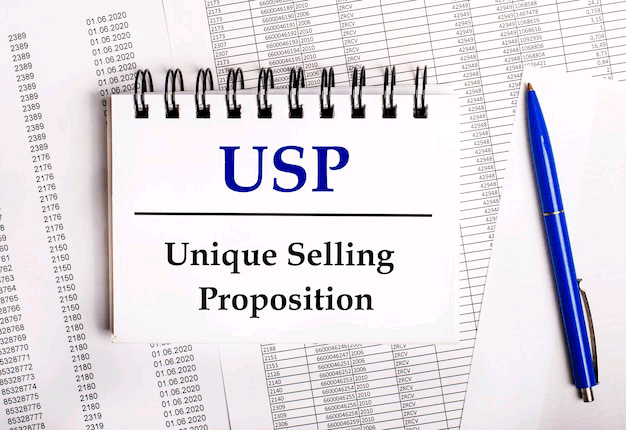

By
Humphrey Udoh
Before you stand out in your business, start by creating a Unique selling proposition and how it can benefit your business.
Ensure you can create one for your business and stand out in the crowd.


Introduction To USP?
Unique Selling Preposition (USP) is an effective marketing technique most businesses utilize to stand out from their competition.
It involves creating a phrase or sentence that can be used to describe your products or services in a way that sets it apart from other similar offerings.
The USP should be short, concise, and memorable, and it should be tailored to the target audience.
The main benefit of having a strong USP is that it creates a competitive advantage. By clearly defining what makes your products or services unique and focusing on that, it can be easier for potential customers to remember what you have to offer.
A well-crafted USP can also help you to build up brand recognition, as customers will be more likely to associate the phrase
What is a Unique selling proposition
A unique selling proposition (USP) is a business statement that communicates the unique benefit or value that a product or service offers to a potential customer in a niche.
It explains why a customer should choose your product or service over those offered by your competitors.
A USP is an important element of a company’s marketing strategy, as it helps to differentiate the company’s offerings from those of its competitors and establish a strong brand identity.
To be effective, a USP must be specific, credible, and relevant to the target market. It should also be easy for customers to understand and remember.
Template for unique selling proposition
Here is a simple template you can use to craft your unique selling proposition:
- Identify your target market: Who is the customer you are trying to reach with your product or service?
- Define the benefit your product or service provides: What specific problem does your product or service solve for your customer? How does it make their life better or easier?
- Make it unique: How does your product or service differ from those offered by your competitors? What sets it apart and makes it special?
- Keep it simple and to the point: Your USP should be short and easy to understand.
Avoid using jargon or technical terms that may be unfamiliar to your target market.
- Test and refine: Once you have a draft of your USP, test it out on a small group of your target market to see if it resonates with them.
Make any necessary revisions based on their feedback.


Here’s an example of a USP:
“Our product is the only one on the market that is made with all-natural ingredients and has been clinically proven to improve sleep quality.
Unlike our competitors, we use only the highest-quality, plant-based ingredients to ensure that our product is safe and effective.
Our customers can trust that they are getting a product that truly works and is good for their overall health and wellness.”


6 Outstanding Statistics About USP You Need To Know


See statistics related to Unique Selling Proposition (USP):
✔64% of consumers purchase after watching a branded social media video that highlights the unique value proposition of a product or service. (Source: HubSpot)
✔A clear and compelling USP can increase customer retention by up to 80%. (Source: Outbrain)
✔A strong USP can increase customer conversion rates by up to 33%. (Source: Business 2 Community)
✔Only 10% of businesses have a strong and well-defined USP. (Source: Forbes)
✔80% of consumers are more likely to do business with a company that offers a personalized experience based on their unique needs and preferences. (Source: Epsilon)
✔Brands that consistently communicate a clear and unique value proposition see average revenue growth of 23%. (Source: CXL)
These statistics highlight the importance of having a clear and compelling USP in today’s competitive market. A strong USP can help businesses stand out, increase customer loyalty and retention, and ultimately drive revenue growth.


How Can You Measure USP Effectiveness
Measuring the effectiveness of a Unique Selling Proposition (USP) can be done using various methods, including:
- Sales data: One of the most common ways to measure the effectiveness of a USP is to track sales data. By comparing sales data before and after the implementation of a USP, you can determine whether the USP is driving more sales.
- Market research: Conducting market research, such as surveys or focus groups, can help you determine whether your USP is resonating with your target audience. You can ask questions to gauge whether consumers understand your USP and whether it influences their purchasing decisions.
- Conversion rates: Measuring conversion rates, or the percentage of visitors to your website who take a desired action (such as making a purchase), can help you determine the effectiveness of your USP. If your USP is effective, you should see an increase in conversion rates.
- Customer feedback: Collecting feedback from customers, such as through reviews or customer service interactions, can provide insight into the effectiveness of your USP. The positive feedback that specifically mentions your USP can indicate that it is resonating with customers.
- Brand recognition: A strong USP can help build brand recognition and awareness. Tracking metrics such as website traffic, social media engagement, and search engine rankings can help you determine whether your USP is contributing to increased brand recognition.
Overall, measuring the effectiveness of a USP requires a combination of quantitative and qualitative data. By analyzing data from multiple sources, you can gain a better understanding of whether your USP is resonating with customers and driving sales.
What Are Some Common Objections To Using A Unique Selling Proposition?
While the USP is a commonly used marketing technique, there are some objections to its use.
Here are a few USP objections:
✔It can be difficult to identify a truly unique selling proposition: Some marketers argue that it is difficult to find a truly unique selling proposition, as most products or services have competitors that offer similar benefits.
✔It may not be relevant to all industries or businesses: Some businesses or industries may not lend themselves to a unique selling proposition, such as commodities or industries with many interchangeable products.
✔It may not be enough to drive sales: While a USP can help differentiate a product or service, it may not be enough to drive sales on its own. Other factors such as price, customer service, and brand recognition may also be important.
✔It can be limiting: Focusing solely on a USP can be limiting and may prevent a business from exploring other marketing strategies.
✔It may not resonate with all customers: A USP may not resonate with all customers, as different customers may have different needs and preferences.
In a nutshell, while the USP is a useful marketing technique, it may not be appropriate for all businesses and industries, and it may not be enough to drive sales on its own. It is important to consider a variety of marketing strategies and tailor them to the unique needs and preferences of your target audience.
How To Overcome This USP Objection
Objections to a USP can arise if a customer or prospect does not see the value in the unique aspect of the product or service. Here are some ways to overcome objections to a USP:
- Understand the customer’s perspective: Take the time to listen to the customer’s objections and concerns. Ask questions to understand their needs, wants, and pain points.
- Communicate the value: Communicate the benefits of the unique aspect of your product or service, and explain how it solves the customer’s problem or fulfills their needs.
- Provide social proof: Use testimonials, case studies, or other forms of social proof to demonstrate how others have benefited from the unique aspect of your product or service.
- Address objections directly: Acknowledge the objection and address it directly. Provide examples, statistics, or other evidence to counter any negative perceptions.
- Offer a trial or demonstration: If possible, offer a trial or demonstration of the unique aspect of your product or service to allow the customer to experience its value firsthand.
- Follow up: Don’t give up on a customer who objects to your USP. Follow up with them after the initial conversation and continue to provide information and support until they make a decision.
By addressing objections in a thoughtful and empathetic way, you can help customers see the value in your unique selling proposition and increase the likelihood of making a sale.
Conclusion
In conclusion about this USP, this is what you need to know.
A unique selling proposition is a valuable marketing tool that can help businesses stand out from the competition. By highlighting the unique benefits of their products or services, businesses can attract more customers and boost their sales.
Like, share, and comment below what you think about it.